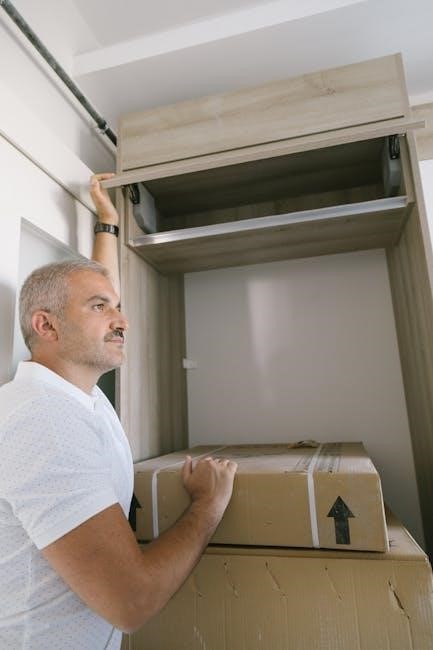Discover the simplicity of assembling RTA cabinets with detailed PDF instructions. These guides provide step-by-step directions, ensuring a seamless DIY experience. From tools to final touches, they cover everything needed for a professional finish.
What Are RTA Cabinets?
RTA (Ready-to-Assemble) cabinets are pre-manufactured cabinet units that require assembly before installation. They are typically shipped flat-packed with all necessary parts, including hardware and instructions. These cabinets are highly customizable, offering a wide range of styles, materials, and finishes to suit various design preferences. Unlike pre-assembled cabinets, RTA cabinets are cost-effective and ideal for DIY projects, providing homeowners with an affordable way to renovate kitchens, bathrooms, or other spaces. They are designed for easy assembly, making them a popular choice for those looking to save money without compromising on quality. The detailed instructions, often provided in PDF format, guide users through the assembly process, ensuring a smooth and successful installation. RTA cabinets are versatile, durable, and perfect for homeowners seeking to enhance their spaces with modern, functional storage solutions.
Why Choose RTA Cabinets?
RTA cabinets are a cost-effective and versatile option for homeowners seeking to enhance their spaces without breaking the bank. They offer exceptional value, combining affordability with high-quality materials and designs. One of the key advantages is their customizability, allowing users to choose from a wide range of styles, finishes, and configurations to match their unique preferences. Additionally, RTA cabinets are ideal for DIY enthusiasts, as they come with detailed instructions, often in PDF format, making the assembly process manageable and straightforward. This ensures that even those with limited experience can achieve professional-level results. The ability to assemble the cabinets oneself also reduces labor costs, further enhancing their appeal. With RTA cabinets, homeowners can enjoy a modern, functional, and aesthetically pleasing storage solution that fits seamlessly into any room design.
Benefits of Using RTA Cabinet Assembly Instructions
Using RTA cabinet assembly instructions provides clarity and confidence during the DIY process. These guides, often available in PDF format, offer step-by-step directions, ensuring every part is assembled correctly. They include detailed diagrams and lists of required tools, reducing confusion and saving time. The instructions also highlight potential pitfalls, helping users avoid common mistakes. Additionally, many PDF guides are interactive, like those from the BILT app, offering 3D visualizations for better understanding. By following these instructions, users can achieve a professional-quality finish without prior experience. The structured approach minimizes errors and ensures all components fit seamlessly. This makes the assembly process more efficient and enjoyable, even for novice DIYers. Overall, RTA cabinet assembly instructions are an invaluable resource for successful and stress-free installation.

Preparation for Assembly
Preparation for RTA cabinet assembly involves gathering tools and materials, understanding the instruction manual, and setting up a safe workspace. Proper planning ensures efficient and error-free assembly.
Tools and Materials Needed
Assembling RTA cabinets requires specific tools and materials. Essential tools include a screwdriver, Allen wrench, rubber mallet, measuring tape, and clamps. Materials like wood glue, screws, and dowels are also necessary. Ensure all components from the RTA cabinet assembly instructions PDF are on hand to avoid delays. Organize tools and parts before starting for efficiency. Refer to the PDF for a detailed list tailored to your specific cabinet model. Having everything prepared ensures a smooth assembly process. Additionally, consider using interactive guides like the BILT app for real-time assistance. Proper preparation minimizes errors and saves time, making the assembly experience more enjoyable and successful.
Understanding the Instruction Manual
Understanding the RTA cabinet assembly instructions PDF is crucial for a successful project. Begin by thoroughly reading the manual to familiarize yourself with the process. Pay attention to diagrams and labels, as they guide you through each step. Ensure all parts are accounted for by cross-referencing the included inventory list. Follow the recommended assembly sequence to maintain structural integrity. Look for tips on avoiding common mistakes, such as misaligning parts or over-tightening screws. Many manuals now include QR codes linking to video tutorials or interactive apps like BILT for enhanced guidance. If unsure about a step, consult the troubleshooting section or contact manufacturer support. Taking the time to understand the manual ensures a smooth and stress-free assembly experience; Proper preparation and adherence to instructions lead to professional-quality results. Start with smaller components to build confidence before moving to larger sections. Patience and attention to detail are key to achieving a flawless finish.
Preparing the Workspace
Preparing your workspace is essential for a smooth RTA cabinet assembly process. Start by clearing a large, flat area to accommodate all components and tools. Cover the floor or work surface with a drop cloth or old sheets to protect against damage. Gather all tools and materials listed in the instructions, and organize them neatly. Use a workbench or sturdy table to assemble smaller parts, ensuring stability. Label each hardware bag to avoid confusion and keep them within easy reach. Position the instruction manual where it’s easily visible, such as on an easel or clipboard. Use clamps to hold panels steady while assembling, and consider enlisting a second pair of hands for larger sections. Finally, ensure the room is well-lit and free from distractions. A well-prepared workspace minimizes errors and speeds up the assembly process. Proper organization is key to a successful and stress-free experience. Stay tidy to avoid losing small parts or misplacing essential items. A clean workspace promotes efficiency and ensures all components fit together perfectly;

Step-by-Step Assembly Guide
A comprehensive guide offering detailed instructions for assembling RTA cabinets. It covers base, wall, and drawer units, ensuring each step is clear and easy to follow for a flawless result.

Base Cabinet Assembly Instructions
Assembling base cabinets is a foundational step in your RTA cabinet project. Begin by unpacking and organizing all components, ensuring no parts are missing or damaged. Start by attaching the legs or base frame to the cabinet body using the provided screws. Align the frame carefully to ensure stability. Next, install the shelves, if included, by securing them to the pre-drilled holes. Use a level to confirm the cabinet is even and plumb. Attach the back panel to reinforce the structure, then proceed to install the doors and drawers according to the manufacturer’s specifications. Use an Allen wrench or screwdriver for most connections. Double-check all alignments and tighten screws firmly. Finally, ensure the cabinet is level and secure before moving on to wall or drawer units. Troubleshoot any misalignments by adjusting the legs or frame. Proper assembly ensures a sturdy and functional base cabinet. Always refer to the RTA cabinet assembly instructions PDF for specific guidance.
Wall Cabinet Assembly Instructions
Assembling wall cabinets follows a structured process to ensure stability and proper installation. Begin by unpacking and organizing all components, including the cabinet body, shelves, doors, and mounting hardware. Attach the hanging brackets to the top and bottom of the cabinet body, ensuring they are evenly spaced and aligned. Use a drill to secure these brackets with screws provided in the RTA cabinet assembly instructions PDF. Next, assemble the shelves by attaching them to the pre-drilled holes inside the cabinet. Use a level to ensure the shelves are straight and evenly positioned. Once the cabinet body is complete, attach the doors using hinges and handles, aligning them precisely for a smooth operation. Finally, mount the cabinet to the wall by screwing it into sturdy wall studs. Ensure the cabinet is level and securely fastened to prevent tipping. Always follow the manufacturer’s guidelines for weight limits and installation requirements. Proper assembly ensures a safe and functional wall cabinet. Refer to the RTA cabinet assembly instructions PDF for detailed diagrams and specific hardware instructions.
Drawer Cabinet Assembly Instructions
Assembling drawer cabinets involves precise steps to ensure smooth functionality. Start by unpacking all components, including the drawer boxes, slides, and fronts. Attach the drawer slides to the cabinet body, aligning them with the pre-drilled holes. Secure the slides using the provided screws, ensuring they are evenly spaced and properly aligned; Next, assemble the drawer boxes by attaching the bottom panel to the sides using cam locks or screws. Attach the drawer fronts to the drawer boxes, ensuring they are flush and evenly aligned. Install the drawer handles or knobs, following the manufacturer’s instructions. Finally, insert the drawers into the cabinet, testing the slides for smooth operation. Use a level to ensure the drawers are properly aligned and adjust if necessary. Refer to the RTA cabinet assembly instructions PDF for detailed diagrams and specific hardware instructions. Proper assembly ensures durable and functional drawer cabinets for years to come.

Common Challenges and Solutions
Common issues include misaligned parts and missing hardware. Use shims for leveling and refer to the RTA cabinet assembly instructions PDF for troubleshooting tips and solutions.
Aligning Cabinet Parts Properly
Aligning cabinet parts correctly is crucial for a sturdy and visually appealing finish. Use shims to level the base and ensure all components fit snugly. Clamp parts together before securing them to maintain alignment. Refer to the RTA cabinet assembly instructions PDF for detailed diagrams and step-by-step guidance. Tighten screws gradually to avoid misalignment. For precise fitting, utilize a rubber mallet to tap parts into place gently. Double-check all pre-drilled holes and edges for proper alignment before finalizing. If unsure, consult the BILT app for interactive 3D instructions to visualize the process. Taking your time ensures a professional result and prevents structural issues down the line.
Dealing with Missing or Damaged Parts
If you encounter missing or damaged parts during assembly, refer to the RTA cabinet assembly instructions PDF for a comprehensive list of components. Double-check your inventory to ensure no items were overlooked. If a part is missing, contact the manufacturer or supplier immediately for a replacement. For damaged parts, assess if they can be repaired or if a replacement is necessary. Use the BILT app for interactive guidance to identify and resolve issues quickly. Keep spare hardware on hand for unexpected repairs. Always follow the manufacturer’s instructions for handling such situations to avoid delays. Patience and proper communication with support teams will help you overcome these challenges seamlessly. Remember, most manufacturers offer assistance for missing or damaged parts, ensuring your project stays on track.
Troubleshooting Common Assembly Issues
Troubleshooting common assembly issues is made easier with the RTA cabinet assembly instructions PDF. Identify and resolve problems quickly by referring to the detailed guide. Misaligned parts are often due to incorrect screw placement; double-check alignment before tightening. If drawers don’t glide smoothly, inspect the slides for proper installation. Uneven cabinets may require adjusting the leveling feet. Consult the PDF for diagrams or use the BILT app for interactive solutions. Don’t hesitate to contact manufacturer support for further assistance. Keep tools organized and follow the sequence carefully to avoid mistakes. Troubleshooting ensures a flawless assembly process, saving time and frustration. With the right resources, even the most challenging issues can be resolved efficiently, leading to a professional-looking finish.

Additional Tips for a Seamless Assembly
- Use the BILT app for interactive guides to enhance your assembly experience.
- Strictly follow the instruction sequence to avoid mistakes and save time.
- Ensure safety by wearing protective gear and keeping tools within reach.
Using the BILT App for Interactive Instructions
The BILT app revolutionizes RTA cabinet assembly by providing interactive, 3D instructions. It guides you through each step with visual clarity, ensuring accuracy and reducing confusion. Key features include:
- Interactive 3D models that allow you to explore parts and connections.
- Step-by-step instructions with tool and hardware requirements.
- Real-time tracking of your progress for better organization.

Download the BILT app for free and enjoy a seamless assembly experience. It’s a game-changer for DIY enthusiasts, making complex tasks manageable and stress-free.
Importance of Following the Sequence
Adhering to the assembly sequence in RTA cabinet instructions is crucial for a successful project. Skipping steps or reordering tasks can lead to misalignment, structural instability, and wasted time. The sequence ensures:
- Proper fitting of parts and hardware.
- Stability and safety of the final structure.
- Efficient use of tools and materials.
By following the instructions methodically, you avoid common pitfalls and achieve professional-quality results. This approach also helps in identifying potential issues early, preventing costly repairs later. Stay organized, follow the sequence, and enjoy a smooth assembly process.
Safety Precautions During Assembly
Safety Precautions During Assembly
Ensuring safety during RTA cabinet assembly is essential to avoid accidents and injuries. Always wear protective gear, such as safety glasses and gloves, when handling tools or materials. Keep loose clothing and long hair tied back to prevent entanglement with power tools. Ensure the workspace is well-lit and clear of clutter to minimize tripping hazards. Avoid overreaching or lifting heavy components without assistance, as this can lead to strain or injury. Use clamps or braces to stabilize parts during assembly to prevent sudden movements. Keep sharp objects and power tools out of reach of children and pets. Follow manufacturer guidelines for tool usage and adhere to all safety instructions provided in the RTA cabinet assembly instructions PDF. Prioritizing safety ensures a smooth and incident-free assembly process.

Finishing Touches
Add the final details by installing hardware and handles, securing cabinets to walls, and conducting a thorough inspection. Adjustments ensure everything fits perfectly and functions smoothly for lasting durability.

Installing Hardware and Handles
Installing hardware and handles is a crucial final step in your RTA cabinet assembly. Begin by locating the pre-drilled holes for knobs or handles, ensuring they align with your design preferences. Use a screwdriver to secure the hardware, tightening firmly but avoiding overtightening that might damage the material. For hinges, attach them to the doors first, then align and screw them into the cabinet frames. Double-check the alignment to ensure doors open and close smoothly. If handles require additional spacing, use spacers provided in the hardware kit. Finally, test all hardware to ensure functionality and make any necessary adjustments. Proper installation guarantees both aesthetics and durability, completing your cabinet assembly seamlessly.
Securing Cabinets to the Wall
Securing your RTA cabinets to the wall is essential for stability and safety. Begin by locating the wall studs using a stud finder to ensure sturdy anchorage. Position the cabinet against the wall, aligning it with a level to maintain evenness; Attach the provided wall brackets or screws to the cabinet’s back panel, then screw them into the wall studs. Tighten all screws firmly but avoid overtightening, which might strip the screws or damage the cabinet. For added stability, use anti-tip brackets, especially for taller cabinets, to prevent tipping. Double-check the alignment and ensure all screws are securely fastened. Properly securing your cabinets protects them from shifting and ensures long-term durability, completing your assembly process effectively and safely.
Final Inspection and Adjustments
After assembling your RTA cabinets, conduct a thorough final inspection to ensure everything is properly aligned and functional. Check that all doors and drawers open and close smoothly, and verify that the cabinets are level and securely fastened to the wall. Inspect all hardware, such as handles and hinges, to confirm they are correctly installed and adjusted. If necessary, use shims to fine-tune the alignment of the cabinets. Address any minor gaps or misalignments by tightening screws or adjusting the hinges. Once satisfied, ensure all protective films are removed from surfaces, and clean the cabinets to prepare them for use. Refer to the RTA cabinet assembly instructions PDF for specific guidance on final adjustments, ensuring your project meets professional standards and remains durable for years to come.

Resources and Support
Access comprehensive RTA cabinet assembly instructions PDF for detailed guidance. Utilize manufacturer support, online forums, and apps like BILT for interactive help, ensuring a smooth assembly process.
Downloading the RTA Cabinet Assembly Instructions PDF
Downloading the RTA Cabinet Assembly Instructions PDF is a straightforward process that provides you with a comprehensive guide for assembling your cabinets. These documents are typically available on the manufacturer’s website or through platforms like TheRTAStore.com. Ensure you have the correct model number to access the specific instructions for your cabinet. The PDF format allows you to easily print or save the guide for reference during assembly. Many manufacturers also offer interactive versions, such as through the BILT app, which provides step-by-step visual instructions. Having these instructions on hand is crucial for a smooth assembly process, as they detail every component and required tool. By following the PDF guide, you can confidently navigate the assembly process and achieve professional-quality results. Always verify the source of the PDF to ensure accuracy and safety.
Accessing Manufacturer Support
Accessing manufacturer support is essential for a smooth RTA cabinet assembly experience. Most manufacturers, such as RTA Cabinet Store, provide dedicated customer service through their websites, email, or phone. These resources are designed to address any questions or issues that arise during assembly. Many companies also offer extensive online support, including FAQs, instructional videos, and downloadable guides like the RTA Cabinet Assembly Instructions PDF. Additionally, some manufacturers partner with platforms like the BILT app to offer interactive, 3D assembly guidance. If you encounter missing or damaged parts, manufacturers often have streamlined processes for replacements. Their support teams are typically knowledgeable and can help troubleshoot common assembly challenges. Reaching out to manufacturer support ensures you have the assistance needed to complete your project successfully. Utilizing these resources can save time and reduce frustration, making your DIY project more enjoyable and stress-free.
Online Communities for Assembly Help
Online communities are invaluable resources for RTA cabinet assembly help. Forums, social media groups, and specialized platforms like Reddit or Facebook often host DIY enthusiasts sharing tips and solutions. These communities provide real-life experiences, troubleshooting advice, and creative hacks for common assembly challenges. Many users upload photos, videos, or step-by-step guides to assist others. Additionally, platforms like the BILT app or manufacturer-specific forums offer interactive support, making complex tasks easier. Engaging with these communities can help you overcome obstacles, learn from others’ mistakes, and gain confidence in your DIY skills. They also serve as a space to ask questions and receive personalized advice from experienced assemblers. Leveraging online communities ensures you have a network of support beyond official instructions, enhancing your overall assembly experience and fostering collaboration among DIY enthusiasts.
Completing your RTA cabinet assembly is rewarding and satisfying. The BILT app and interactive guides ensure success. With proper tools and preparation, DIY enthusiasts can achieve professional results. Manufacturer support is key.
Summarizing the Assembly Process
Assembling RTA cabinets involves a structured approach: start with unpacking and organizing parts, follow the provided instructions, and systematically build each component. Begin with the base, then move to walls and drawers. Use the BILT app for interactive guidance. Ensure each step aligns with the manual to avoid errors. Secure cabinets to the wall for stability and safety. Install hardware last. The process requires patience and attention to detail but offers a sense of accomplishment. Proper preparation and adherence to instructions are key to a successful assembly. Troubleshoot any issues by referring to the manual or manufacturer support. DIY enthusiasts will find the project rewarding, enhancing their space with custom cabinets.
Encouragement for DIY Enthusiasts
Embrace your creativity and skill with RTA cabinet assembly! DIY projects offer a sense of pride and customization. With clear instructions, you can transform your space without professional help. Start by understanding the manual and preparing your tools. The process may seem daunting, but each step brings you closer to your vision. Use online resources or the BILT app for guidance. Join online communities for tips and support. Remember, patience and attention to detail are key. Troubleshoot issues with ease by referring to the provided guides. The satisfaction of completing your project is rewarding. Take your time, stay organized, and enjoy the journey of creating something functional and beautiful for your home. DIY enthusiasts will find this project both challenging and fulfilling, enhancing their skills and confidence.
Final Thoughts on RTA Cabinet Assembly
RTA cabinet assembly is a rewarding DIY project that saves money and enhances your home. With PDF instructions, the process is streamlined, ensuring accuracy and efficiency. Start by gathering tools and understanding the manual; Prepare your workspace to avoid clutter. Follow the step-by-step guide for base, wall, and drawer cabinets. Address challenges like part alignment and troubleshoot issues promptly. Utilize resources like the BILT app for interactive guidance. Safety is crucial, so wear protective gear and work carefully. After assembly, install hardware and secure cabinets to walls; Conduct a final inspection to make adjustments. For support, download the RTA cabinet assembly instructions PDF or contact manufacturers. Join online communities for additional help. Completing this project gives a sense of accomplishment and improves your DIY skills. RTA cabinets are a cost-effective solution for customizing your space without compromising quality. Embrace the challenge and enjoy the results of your hard work.
